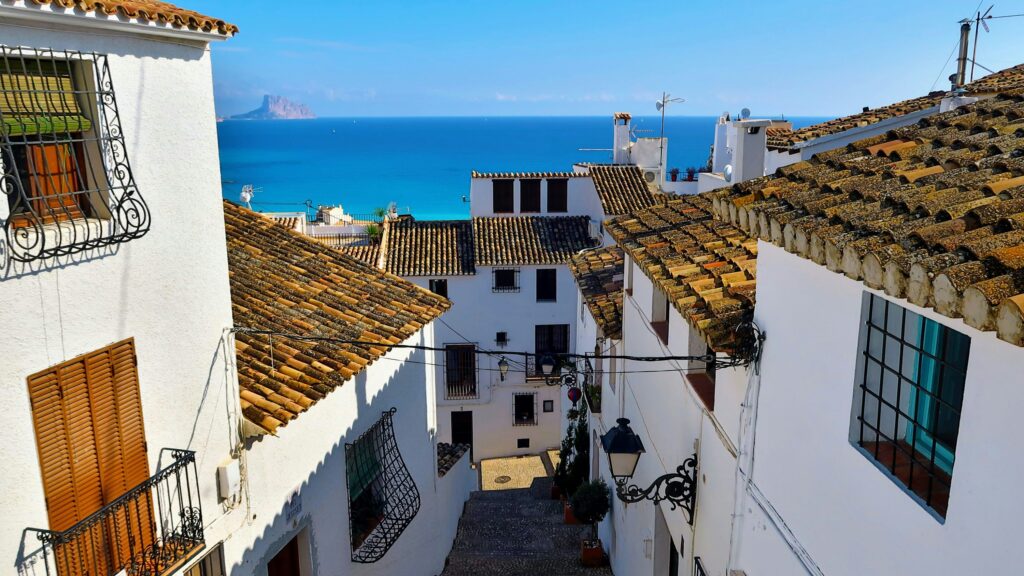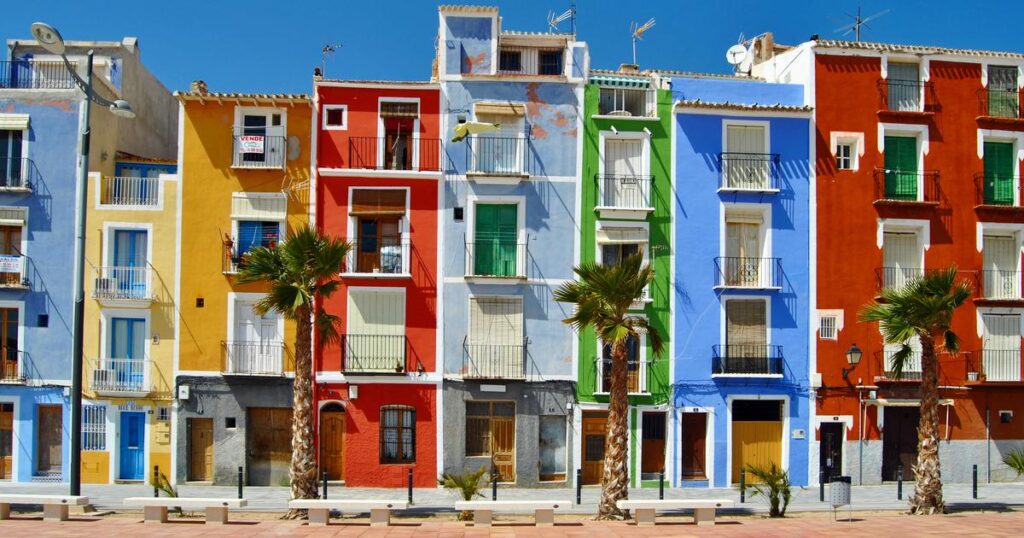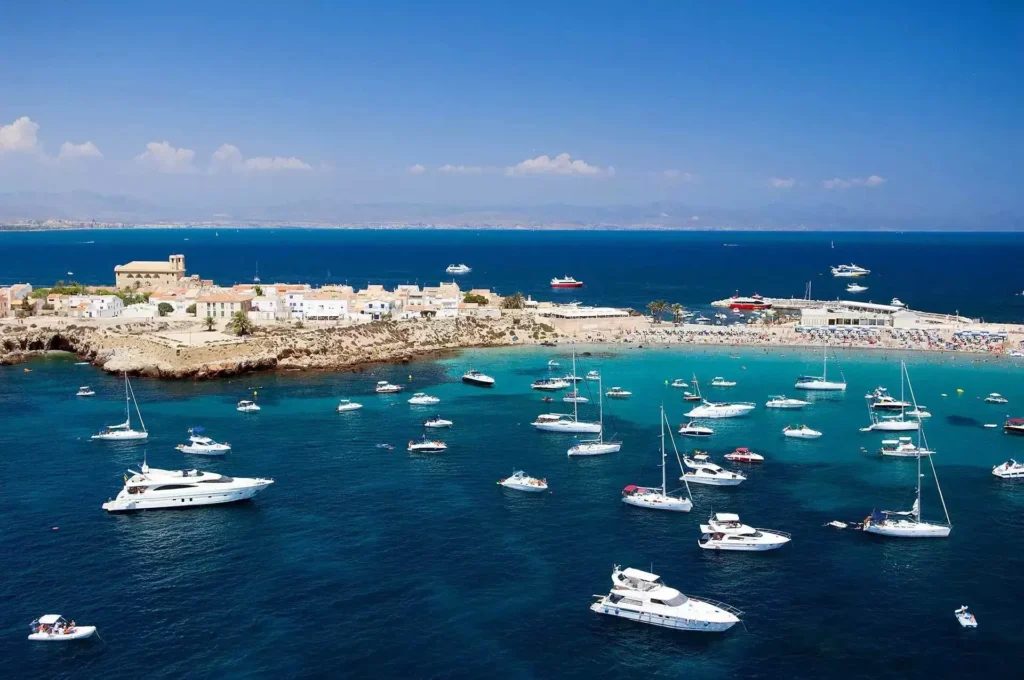Let’s get one thing straight—Alicante is not just one city. It’s an entire world of seaside towns, mountain villages, pink salt lakes, and ancient castles carved into cliffs. Sure, the capital city gets most of the international love—and it’s easy to see why. With its palm-lined promenades, golden beaches, and tapas joints that spill onto sun-drenched plazas, Alicante city is magnetic.
But here’s the insider truth: the real Alicante experience happens when you leave the city behind.
When you rent a car, hop a tram, or follow the coastline on a slow road trip, you’ll start to see the true soul of this stunning slice of Spain’s Costa Blanca. You’ll find sleepy fishing villages where time stands still. Mountain-top towns with jaw-dropping views and zero crowds. Colorful beach houses. Bohemian art hubs. Flamingos. Castles. Chocolate factories. Pink lakes. It’s all here—and none of it is on your average travel brochure.

In fact, Alicante province might just be one of Spain’s most underrated travel destinations. It’s got all the Mediterranean magic of Catalonia or Andalusia, but with fewer tourists, lower prices, and a sense of discovery that hasn’t been diluted by mass tourism.
In this blog post, we’re skipping the typical city-break itinerary and going deeper. These are the 5 best towns in Alicante to visit—each one a storybook destination with its own vibe, flavors, festivals, and natural wonders. From clifftop castles to island escapes, prepare to fall in love with the other side of Alicante.
Let’s go exploring.

1. Altea – The Bohemian Beauty of the Costa Blanca
Altea is the kind of town that feels like it was painted by hand. Perched on a hillside overlooking the sea, this whitewashed village is famous for its winding cobbled streets, dazzling blue-domed church, and a golden light that has long inspired artists, photographers, and dreamers.
What to Do:
Start your journey in the Casco Antiguo (Old Town), a labyrinth of white houses draped in bougainvillea. Climb up to Plaza de la Iglesia where the view stretches out across the Mediterranean, and street performers add a soundtrack to your stroll.
Altea’s creative spirit is everywhere—local artists sell handmade ceramics, jewelry, and paintings from studios tucked into alleyways. The town also plays host to Castell de l’Olla, a dazzling firework display in August launched over the sea in synch with music. If you’re visiting in September, the Moros y Cristianos festival brings the streets alive with parades, costumes, and fireworks in celebration of Altea’s medieval past.
What to Eat:
Food here is simple and soulful. Try arroz del senyoret—a rice dish loaded with peeled seafood, cooked in local fish broth—and pulpo a la gallega, served tender with olive oil and paprika. For dessert? Grab a scoop of turrón ice cream, made from local almond nougat.
Insider Tip:
Want the best photo of Altea? Walk up behind the church to Mirador Cronistas de España right before sunset.

2. Villajoyosa – Colorful Coastlines & Chocolate Dreams
Villajoyosa (aka “La Vila Joiosa,” meaning the joyful village) lives up to its name. This small seaside town is famous for its rows of pastel-colored houses lining the beach—once painted that way so returning fishermen could spot their homes from sea.
But Villajoyosa isn’t just a pretty face. It’s also the historical chocolate capital of Spain.
What to Do:
Begin your day with a walk along Platja Centre, the main beach. It’s long, clean, uncrowded, and fringed with palms and seafood restaurants.
Then head into town to visit the Valor Chocolate Museum, where Spain’s oldest chocolatier (established 1881) shows you how cocoa made its way from the Americas to Spain—and into your churros.
For history lovers, explore the remains of the 16th-century city walls, the Gothic Church of the Assumption, and the colorful fishing district of El Arsenal.
What to Eat:
Villajoyosa is a seafood town through and through. Order fideuà—a noodle-based version of paella with cuttlefish and monkfish—or try salazones, the town’s famous cured fish (especially bonito and anchovies).
Insider Tip:
Pick up some artisanal chocolate from Chocolates Pérez or Chocolates Clavileño—less famous than Valor, but local favorites with bold flavors like orange peel, almond, and chili.

3. Guadalest – A Castle in the Sky
If you’re ready to trade sand for stone and sea breeze for mountain air, Guadalest is your dream destination. Tucked deep in the Alicante interior and set high atop a rocky outcrop, this fairytale town is one of Spain’s most beautiful hidden gems—and a declared Historic-Artistic Site.
What to Do:
The highlight here is the Castell de Guadalest, a medieval fortress accessed through a stone tunnel carved into the mountain. From the top, you’ll get sweeping views of the turquoise Guadalest reservoir and surrounding Sierra de Aitana mountains.
The village itself is tiny but packed with quirky charm. There are over 10 micro-museums here—like the Museum of Miniatures, the Salt & Pepper Shaker Museum, and even a Medieval Torture Museum.
Want to stretch your legs? Take the short hiking trail around the reservoir, or climb up to Penya l’Alcala for a secluded lookout point.
What to Eat:
Try gazpacho manchego, a meaty stew served on flatbread, or conejo al ajillo—garlic rabbit cooked with rosemary and local olive oil. Finish with a glass of mistela, a sweet local wine made from Muscat grapes.
Insider Tip:
Get here early in the morning or visit just before closing time—tour buses flood in mid-day, but the golden-hour views in near solitude are unforgettable.

4. Santa Pola – Salt Flats, Flamingos, and Island Hopping
Just 20 minutes south of Alicante city, Santa Pola is a working-class coastal town that surprises with its quiet beauty, natural wonders, and old-school maritime culture. It’s also your launching point for one of the best hidden gems in the province: Tabarca Island.
What to Do:
Start with the Salinas de Santa Pola, vast pink-hued salt flats that attract thousands of migratory flamingos. The viewing decks and bike trails make for a tranquil early-morning escape.
Next, take a boat to Isla de Tabarca—Spain’s smallest inhabited island, where pirate history meets marine reserves. Tabarca is ideal for snorkeling, slow lunches, and cliffside views.
Back in Santa Pola, visit the 16th-century castle-fortress, walk the fishing port, or hike up to the Santa Pola Lighthouse for stunning coastal views.
What to Eat:
This is seafood central. Order caldero tabarquino, a rich fish and rice stew cooked in copper pots, or try grilled dorada (sea bream) fresh from the day’s catch. Many harbor restaurants offer menú del día deals with wine, starters, and dessert for under €20.
Insider Tip:
Avoid peak weekends if you’re heading to Tabarca. Go early and return after sunset for the best light and fewer crowds.
5. Torrevieja – Pink Lakes and Local Flavor
Often overlooked by international travelers, Torrevieja has quietly become a nature and wellness destination thanks to its Laguna Rosa—a bubblegum-pink salt lake like something from a Wes Anderson dream. But there’s more to this town than Instagram shots.
What to Do:
The Laguna Rosa is the main draw, part of the Natural Park of Lagunas de La Mata y Torrevieja. The lake turns pink due to microorganisms and salt content, and while swimming is off-limits, you can walk along designated trails or birdwatch flamingos and herons.
In town, stroll the Paseo Marítimo (seaside promenade), visit the quirky Museo del Mar y de la Sal, or catch local theater and live music in the lively central square.
Nearby beaches like Playa de la Mata offer a more local, relaxed vibe than those in larger cities.
What to Eat:
Try sepia a la plancha (grilled cuttlefish), tapas with alioli, and churros con chocolate from street stalls. The Saturday market in Torrevieja is one of the largest in Spain—perfect for olive oil, cheese, and spice hunting.
Insider Tip:
The pink color is brightest in late summer and at sunset—bring polarized sunglasses to really see it pop.
Practical Tips for Visiting These Towns
When to Go:
April to June and September to October are ideal for warm weather without the summer crowds.
July & August are festival-heavy but hot and busy—perfect if you love that buzzing Mediterranean energy.
Getting Around:
Rent a car if you want to hit all five towns in one trip.
Coastal towns like Altea, Villajoyosa, and Torrevieja are also accessible via tram or bus from Alicante city.
What to Pack:
Light layers, good walking shoes, reef-safe sunscreen, and an appetite for wine and seafood.
How Long to Stay:
Each town deserves at least a full day. Base yourself in Alicante city or rotate between towns if you’re staying longer.
The Real Alicante is in Its Towns
These aren’t just pretty stops—they’re whole worlds. Villages carved into mountains. Towns painted by fishermen. Fireworks over the sea. Chocolate, paella, salt lakes, and ancient castles. In Alicante province, every town tells a different story—and you’ll want to hear them all. So skip the mega resorts. Hit the road. And find your favorite hidden gem along Spain’s Costa Blanca.